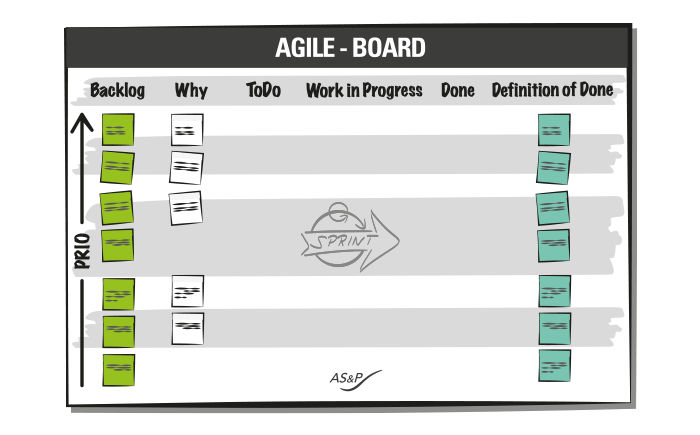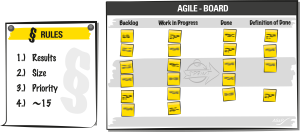
No Post-It jungle.
An AGILEBOARD usually has five columns:

The first for the backlog,
the second describes the benefit for the client, the meaning, the WHY,
the third is called “Work in Progress”,
the fourth “Done”
the fifth “Definition of Done” (DoD).

5 rules for the backlog.
1. Result no activity
The wishes should be formulated in terms of results that are as concrete and measurable as possible. Describing activities is a typical trap that can lead to misunderstandings in the end. A result wish is formulated briefly and crisply, ideally three words.
Goethe wrote a 40-page letter to his best friend and ended with the last sentence: “Sorry the letter got so long – I didn’t have time to be shorter.”
2. Backlog size
All requests should be of similar size. Work items that are too large are divided into several smaller ones. Work items that are too small are grouped together.
Tip: start without effort estimation (so-called estimation), optimise later with storypoints or estimation methods. The planning poker cards help to find out if we have big differences around understanding and should deepen the clarification.
3. Approx. 15 backlog items
The backlog list should be clear and easy to understand and, above all, it should not contain any restrictions or specifications for the implementation of the wishes: The WHAT is described and not the HOW.
For a team of >10 and a 2-week sprint, a limit of about 15 backlog items has proven to be effective. With 15, a good balance of clarity and concentration on the WHAT content is achieved. Much more than 15 are usually too detailed and contain too much HOW.
4. Prioritisation
Finally, the list of about 15 cards is rearranged in order of importance. What happens now is revolutionary and crucial for many companies:
The team, consisting of market, technical and project representatives, has to agree on prioritisation. For the product manager, this means turning away from the all-is-important mindset. Particularly in the first conclave, the use of the paired comparison method has proven its worth:
The cards are written on twice and stuck on at a 90° angle to each other. Now each card is compared with every other card. For each pair, an answer must be found to the question: Which is more important? This automatically creates an order.
5. The Why
Every 2 weeks the POT has a chance to give the why. The team is given a deeper and broader understanding. The intention behind the outcome definition of the backlog item becomes clearer. When the team understands the WHY, they can have a more constructive say, develop even better proposals. More perfect, simpler and smarter solutions are the result.
The most decisive reason for this exercise is the mental side: teams are respected at eye level and not treated as recipients of orders. For this purpose, it has proven useful to install another column on the AGILEBOARD by defining the WHY for each backlog item.